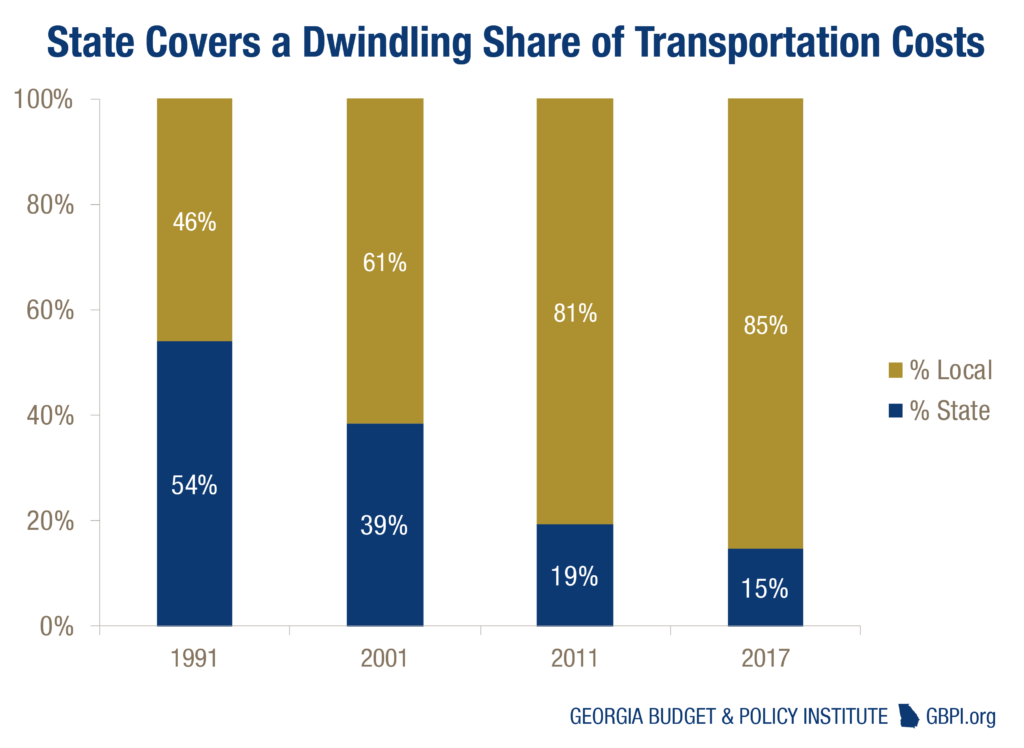Georgia lawmakers reached a critical milestone during the 2018 legislative session: They ended 16 years of shortchanging the state’s formula for funding K-12 schools. The General Assembly added $167 million to the 2019 state budget to send school districts across Georgia the full amount promised under the formula for the first time since 2002. It puts a stop to funding cuts that soared to $1 billion each year from 2010 to 2014. It helps ensure all students will get more of the resources they need to succeed in school. Schools still face financial challenges that make meeting students’ needs difficult, such as:
- Reduced state funding for student transportation over time, despite a modest boost this legislative session; this trend pushes school districts to shift local money from classroom instruction to busing
- State funding that fails to keep pace with inflation
These challenges are exacerbated by changes in other areas of state funding for public schools including the equalization program that aims to give a boost to districts with less property wealth, health insurance and teacher retirement benefits.
These deficiencies are tied to a larger problem: Georgia’s 33-year-old funding formula no longer reflects students’ needs or the ambitious learning goals the state now sets for them. This is particularly burdensome for low-income students and the schools that serve them. These students face hurdles that too often limit their learning and need extra support and resources to overcome them. With more resources, low-income students reach higher levels of academic achievement, stay in school longer and earn more as adults.
Legislators can build on successfully filling the 16-year-old budget hole and tackle the flaws in the funding formula. They should conduct a comprehensive assessment of the cost of educating all of Georgia’s students to the state’s current academic performance goals. This assessment will serve as the foundation for a new formula that identifies how much money is needed to support student success in the skill-driven 21st century economy and supply Georgia with the workforce it needs to thrive.
Falling State Funds for Student Busing
The cost of busing students to and from school is shared between Georgia’s state government and local taxpayers. The state’s portion shrank drastically over the past quarter century. The amount lawmakers sent districts in 2017 covered less than 15 percent of the $884 million they spent to bus students, down from 54 percent in 1991.[1] Shrinking state funds and rising costs for student transportation push more financial strain onto local taxpayers and make it harder for districts across Georgia to get students to and from school safely.

The state did not fully fund the amount of transportation dollars called for in its own transportation formula, which accounts for much of the shortfall. The state’s funding formula called for sending $302 million to districts in 2017 but the Legislature approved just $130 million. Rapidly rising costs, not captured in the formula, worsen the effect of this shortfall.
The state’s low and inconsistent allocation of money for bus replacement makes matter worse for school districts. Funding for bus replacement trended mostly downward since 2000 when the state allocated $34.5 million for that, with some fluctuations. The declining investment translates to more than 3,600 buses on the roads that are at least 15 years old.[2] The Georgia Department of Education estimates an investment of $248 million from 2019 to 2022 will allow districts to get these old buses off the road.[3]
Lawmakers took a step in the right direction during the 2018 legislative session by adding $930,000 to the transportation formula and $15 million in bonds for bus replacement. School districts are still left covering the gap in state funding by shifting local dollars from the classroom to student transportation.
State Dollars for Students Don’t Keep Pace with Inflation
The cost of supplies, services and staff needed to operate schools typically rises with inflation but the state’s K-12 funding formula does not routinely follow. The formula receives periodic updates since its implementation in the 1986-1987 school year but these adjustments are sporadic and lag behind actual inflation. Districts are on the hook for escalating costs.
This problem is illustrated by the infrequent adjustments to the formula’s instructional operational costs for each kindergartener. These costs include paper, books, lab equipment and replacement equipment. The state changed spending on these things four times between fiscal years 2002 and 2019, including one cut. The $93.46 allocated for each kindergartener’s’ materials in the 2019 budget is higher than the dollar amount from much of the past decade before adjusting for inflation. The state should budget about $116 per kindergartener for the 2018-2019 school year to keep pace with inflation since 2002. Across grade levels and schools, this funding gap adds up. A school with 80 kindergartners should get about $1,800 more for materials and supplies for these students in the 2018-2019 school year if adjusted for inflation.

Funding Changes Squeeze School Districts’ Budgets
Lawmakers added other financial burdens to the district level financial squeeze in recent years. In 2012, lawmakers downsized the equalization program, which sends more state money to districts with lower taxable property values. The revised program cut the number of districts that receive equalization grants and reduced the amount they receive from past levels.[4]
Districts are now on the hook for the full cost of health insurance for bus drivers, custodians and other non-teaching staff through the State Health Benefit Plan, a cost once shared with the state. Lawmakers first reduced the state’s contribution in 2009 and eliminated it in 2012. To cover this gap, plan administrators increased the monthly amount districts must pay for each of these employees to $946 from $218. Georgia’s 180 school districts now collectively pay $430 million more annually to provide health insurance for these workers.
Rising retirement costs also add to districts’ financial stress. The districts’, or employers’, contribution to the Teacher Retirement System rises to 20.9 percent from 16.8 percent in the 2019 budget. This follows several years of increases. The state covers the contribution to the retirement system for the portion of teachers’ salaries it pays.
To offer competitive wages and attract effective teachers, most school districts supplement the salary the state provides. Districts pay the employer’s contribution on these supplements and rising retirement costs have hit local budgets hard. Fulton County Schools estimates the retirement system increase will cost an additional $21.9 million in its 2019 budget, far surpassing the $7 million in state funds the district will receive through the elimination of the austerity cut.[5]
Outdated Funding Formula Lags Behind Today’s Needs
The General Assembly approved Georgia’s current formula to fund public schools in 1985 and implemented it in the 1986-1987 school year. Lawmakers tinkered with it since, but the formula needs a comprehensive review and revision to align it with the rigorous academic goals Georgia now sets for students, as well as their changing needs.
Student Expectations Much Higher Now
State leaders raised student performance standards several times over the 33 years since the state adopted its funding formula. Performance standards outline what students are expected to know and be able to do in each grade level and subject area. The Georgia Standards of Excellence are the objectives now in place and are more rigorous than the ones in place in 1985. Today’s standards are designed to prepare every student for college and a career. Lawmakers left the funding formula unchanged rather than align it with the new standards and provide each district with the resources students need to meet expectations.
More Students from Difficult Backgrounds
The low-income student population in Georgia’s public schools grew to more than 60 percent today from 45 percent in 2002, as measured by participation in the federal free- and reduced-lunch program. These children typically face hurdles to high levels of academic achievement, including limited literacy development, unstable housing and physical and mental health problems.[6]
These barriers can be overcome through small class sizes in early grades, one-on-one instruction, literacy specialists, access to counselors and social workers, school-based health clinics or other medical services and other strategies. This extra support requires additional money. When supplemental money is provided and sustained, low-income students do better in school and are more financially secure as adults. The likelihood that they will graduate from high school jumps about 10 percent and the wages they earn as adults climbs by about 13 percent.[7]
Recommendations
Lawmakers increased state spending for public schools in recent years, culminating with an additional $167 million in the 2019 budget. These increases helped end deep cuts to the K-12 funding formula, cover student enrollment growth and shore up the teacher retirement system. Though constrained by soaring health insurance and student busing costs, districts used the money to undo some of the damage caused by the many years of so-called austerity cuts. School districts got students back in class for the standard 180-day school calendar, reinstated some of the collective10,000 eliminated teaching positions, ended teacher furlough days in most communities, and restored some of the discontinued art, music and other programs.[8]
Lawmakers tackled one of Georgia’s public schools’ biggest financial challenges of the last 16 years and they should now look to the future. Georgia needs to develop a workforce with the knowledge and skills that will attract and develop high-wage industries. Its economic future and the well-being of communities across the state depend on it. Reaching that goal requires a strong system of public schools that provide every student an opportunity to learn. Such systems include high quality teaching, rigorous standards and assessments aligned to those standards, areas where Georgia is making progress. It also requires adequate funding, where Georgia continues to fall short. To fix this in the short-term, the General Assembly should:
- Cover a minimum of 50 percent of districts’ state-mandated transportation costs as calculated using current student bus usage data
- Pay for the replacement of school buses 15 years and older and ensure that districts are able to comply with the Georgia Department of Education’s recommendations for the life cycle of buses
- Update the state’s 33-year-old school funding formula to adjust for inflation and do that regularly in future years
To provide schools with adequate funding long-term, the General Assembly should also initiate a study to determine the cost to make sure every student is able to meet the goals outlined in the Georgia Standards of Excellence. This is essential to design a school funding system that aligns with performance standards. The Legislature can then develop a new funding formula based on the study’s findings and plan to fully implement it. Georgia is well-positioned to the lead the region and the nation in economic development. That will require strategic investment in tomorrow’s workforce. A new education funding formula, based on a careful cost assessment, lays the foundation for these investments and improved learning for all students.
Endnotes
[1] Suggs, C. (2018). Shrinking state funds trigger student bus safety concerns. Atlanta, GA: Georgia Budget and Policy Institute. Retrieved April 10, 2018 from https://gbpi.org/wp-content/uploads/2018/02/2018-Georgia-Student-Transportation-Report.pdf.
[2] Georgia Department of Education. (2017). Pupil transportation division legislative report. Atlanta, GA: same.
[3] Georgia Department of Education. (2017). Pupil transportation division legislative report. Atlanta, GA: same
[4] Johnson, C. (2012). Bill analysis: House bill 824. Atlanta, GA: Georgia Budget and Policy Institute. Retrieved April 10, 2018 from https://gbpi.org/wp-content/uploads/2012/02/Bill-Analysis-HB-824.pdf
[5] Morales, R. personal communication, April 17, 2018.
[6] Suggs. C. (2017). Tackle poverty’s effects to improve school performance. Atlanta, GA: Georgia Budget and Policy Institute. Retrieved April 10, 2018 from https://gbpi.org/2017/tackle-povertys-effects-improve-school-performance/
[7] Jackson, C.K., Johnson, R. and Persico, C. (2015). Boosting educational attainment and adult earnings: Does school spending matter after all? Education Next 15(4). Retrieved April 10, 2018 from http://educationnext.org/boosting-education-attainment-adult-earnings-school-spending/
[8] For more information on the effects of the austerity cuts, see Suggs. C. (2013). Cutting class to make ends meet. Atlanta, GA: Georgia Budget and Policy Institute. Retrieved April 10, 2018 from https://gbpi.org/wp-content/uploads/2013/11/Cutting-Class-to-Make-Ends-Meet.pdf








